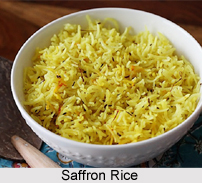 Saffron Rice is made in Kashmiri Cuisine and is usually served with Kashmiri Rajma Curry and Dahi Baingan. Saffron Rice is a similar version to Kashmiri Pulao but the former is the slightly spicier version where as the latter is mildly sweetened and loaded with dry fruits and sometimes fruits. It is so easy to make but very exotic. Saffron Rice is mildly spiced and hence it can be pair with spicy or mildly spiced gravies and dal varieties like "Mirchi Ka Salan", "Mixed Vegetable Kurma", "Matar Paneer", "Paneer Makhani", "Vegetables Makhani", "Dal Fry", "Dal Makhani", "Rajma Masala" and "Creamy Lobia".
Saffron Rice is made in Kashmiri Cuisine and is usually served with Kashmiri Rajma Curry and Dahi Baingan. Saffron Rice is a similar version to Kashmiri Pulao but the former is the slightly spicier version where as the latter is mildly sweetened and loaded with dry fruits and sometimes fruits. It is so easy to make but very exotic. Saffron Rice is mildly spiced and hence it can be pair with spicy or mildly spiced gravies and dal varieties like "Mirchi Ka Salan", "Mixed Vegetable Kurma", "Matar Paneer", "Paneer Makhani", "Vegetables Makhani", "Dal Fry", "Dal Makhani", "Rajma Masala" and "Creamy Lobia".
Rice is an integral part of Kashmiri cuisine and is cooked in many ways. Saffron is the one of the most expensive spices available and is grown in Kashmir in abundance. It adds a delicate sweet fragrance to any recipe. Saffron is not only added for aroma but also for the fact that it has many health benefits. It is anti-depressant, anti-oxidant and has anti-cancer properties and also acts as anti-aging agent. It is also good for digestion, blood circulation and good for eye sight.
Ingredients:
•Basmati Rice - 1 heaped cup
•Cashew nuts - 12 to 15
•Mint leaves - 8 to 10 (optional)
•Turmeric powder - 1/2 tsp (optional)
•Saffron strands - 12 to 15
•Cinnamon - 3/4 inch
•Cloves - 4
•Green Cardamom - 3
•Bay leaves - 1 or 2
•Shahi jeera (black cumin seeds) - 1 tsp
•Salt to taste
•Oil - 1 tbsp
•Ghee - 1 tbsp
•Caramelized onions, to garnish (optional)
•Warm Milk - 1/2 cup
•Water - 2 cups
Method:
•Wash and soak basmati rice in water for 10 minutes. Do not wash more than twice as it looses its fragrance.
•Crush the saffron strands slightly in hand and soak them in a tbsp of warm milk for 10-15 minutes.
•Heat oil and ghee in a thick pan and fry cashew nuts until they turn golden in colour and remove them and keep aside.
•In the same oil add Shahi jeera and let them crackle.
•Add cloves, green cardamom, cinnamon and bay leaves and fry them for a minute. Slightly open the cardamom pods before adding so that they do not splutter.
•Add drained basmati rice and turmeric powder and fry well for a couple of minutes until dry. Do this step carefully as the rice might get broken.
•Add saffron strands soaked in milk to it.
•Add 2 cups of water and let it come to a boil.
•Add salt and mint leaves. Cover it and let it simmer for 12-15 minutes until done.
•When the water dries up, switch off the flame and leave it for 10 minutes and then gently fluff it up using a fork and add fried cashew nuts and mix.
•Garnish with fried onions and cashew nuts.




















